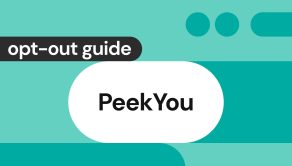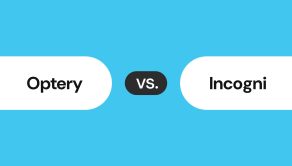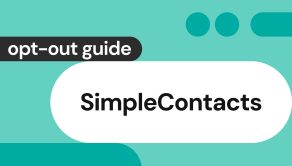Top Incogni alternatives for 2025: compare privacy protection tools

Data privacy is more important than ever in a world where nearly every website, app, and device we interact with collects our personal information. Data brokers take it even further–they aggregate this information and combine it into personal profiles, than license the profiles to other businesses or even publish them online for anyone to access.
Incogni can help you remove your personal information from data broker sites, but the service has its limitations. We tested five Incogni alternatives and compared various factors such as removal quality, data broker coverage, and pricing to help you choose the service that best suits your needs.
What Is Incogni?
Incogni is a privacy protection service that automates requesting the removal of personal data from data brokers. It covers over 200 sites–mainly non-public data brokers, which they categorize into marketing, risk mitigation, and recruitment brokers, as well as some people-search sites. Here’s how Incogni works:
- The service uses an algorithm to predict which data brokers have your personal info
- Then, it automatically sends opt-out requests to those sites
- Once brokers confirm removal, Incogni considers them completed
- If a site does not comply with a removal request, Incogni can file a complaint
- Incogni emails weekly progress updates and users can check progress in their dashboard 24/7
Incogni is a simple and user-friendly service that focuses on data broker removal. It does not offer additional features like dark web monitoring or email masking.
However, when we tested Incogni, we noticed a couple of limitations:
- Incogni can’t scan the majority of data brokers it covers because those sites don’t have publicly available databases. This means that Incogni can’t tell if a broker even has your information before sending a removal request.
- Nevertheless, Incogni does send automatic removal requests to non-public brokers. Such requests typically require sending your personal details so that brokers can find the correct records in their databases and suppress them. However, sending your data to sites without knowing if they even hold it can expose your personal information to those that never did.
- Since Incogni cannot scan non-public data brokers, it cannot verify that your data has truly been removed and must rely on brokers’ responses and confirmations.
- While Incogni seems to scan the people-search sites it covers, its dashboard doesn’t provide the personal details Incogni finds, links to pages with exposed info, or screenshots of profiles. Thus, there’s not much transparency about what exact records Incogni removes.
- While Incogni sends all requests automatically, completing removals may require user assistance. In our experience, some brokers emailed us directly to confirm our requests.
While Incogni is certainly capable of removing personal information from some data broker sites, these limitations can be a deal-breaker for some people. Here’s what you should keep in mind when evaluating alternatives.
Factors to consider when choosing a data removal service
Number and types of data broker websites covered
It’s important to choose a service that covers enough data brokers to meaningfully reduce your digital footprint. That said, more isn’t always better – it’s also critical to consider the types of brokers covered. While you may want to be removed from marketing data brokers to reduce spam, their databases are typically private and not publicly available. People-search sites, on the other hand, make your personal information easily available online to anyone interested, including fraudsters, cybercriminals, and other ill-wishers. So, if you aim to protect your privacy and avoid being a target of scams, phishing, stalking, identity theft, and other threats–it’s imperative to opt out of people-search sites first.
Scanning capabilities
While non-public data brokers can’t be scanned for your information, people-search websites can as they have publicly available catalogs. This is important not only for checking if they publish your data before sending an opt-out request but also for verifying that your information is gone after the request is completed.
Still, not every data removal service scans people-search websites–some simply send removal requests to every broker on their list. Others don’t scan the sites completely but focus on specific pages. The most robust services are capable of scanning data broker sites completely to find all the pages where your information is exposed.
Tracking removal progress
Some services have confusing and complicated dashboards, while others offer clear, intuitive interfaces that provide a good understanding of your removal progress and remaining exposure. Choose a service that allows you to track not only your overall progress but also individual status for each data broker site.
Another important point to consider is whether a service provides links to the pages where your personal data is published, attaches screenshots of exposed data, lists the personal details it finds or uses any other way to show you what profiles it finds and removes. If a service does none of those things, you will have little understanding of what’s going on and whether it’s actually reducing your online footprint.
Ongoing monitoring
If a data broker doesn’t hold your information today, it doesn’t mean they won’t publish it later. Additionally, brokers often update their databases and your data may reappear even after being removed. That’s why regular monitoring is imperative to catching new exposures and dealing with them on time.
Customer support
Responsive, helpful, and friendly customer support is an important part of any service, especially the one that deals with your personal data. Look for a service that offers multiple support options so you can communicate via your preferred channels.
User reviews
Take time to read reviews of other users, which can lend valuable, accurate customer journey insights. Choose a service that has good reviews, but also take bad ones with a grain of salt – especially if the reviewer seems upset about something that’s outside of the service’s control.
Pricing
Privacy protection shouldn’t burn a hole in your pocket. However, going for the lowest price may result in little improvement in your online exposure. To determine whether a service is worth the money, evaluate the quality of removal and reporting by looking at the factors described above.
Top alternatives to Incogni
| No. of data brokers covered | Types of data brokers covered | Ongoing monitoring | Shows what profiles it finds and removes | |
|---|---|---|---|---|
| Onerep | 232 | People-search sites | Yes | Yes, provides the details found on each site and links to pages with exposed data |
| DeleteMe | 750+ (but around 100 on a Standard plan) | People-search sites | Yes | Provides profile links for some sites in quarterly reports |
| Privacy Bee | 300+ | People-search sites, non-public databases | Yes | Provides links to some pages with exposed data |
| Kanary Copilot | Around 10 | People-search sites | n/a | Yes, in real-time while scanning |
| Optery | 85 – 605+ (depending on your plan) | People-search sites, non-public databases | Yes | Yes, provides links and screenshots of exposed profiles |
Option 1: Onerep
Onerep focuses on data brokers with publicly available catalogs AKA people-search websites, currently covering 232. Focusing on people-search sites allows the service to eliminate guesswork and find the exact pages where your personal information is published. This also helps clean up Google search results for your name as people-search websites are usually among the top results when someone looks you up.
Here are key details to know about Onerep:
- Onerep’s TrueScanTM technology allows the service to scan every website it covers to locate users’ personal data and verify that it’s gone after an opt-out request.
- Onerep lists the personal details it finds on each broker and adds the links to the pages where the details are exposed to the dashboard so that you can see what’s being removed.
- Onerep’s dashboard lets you track your overall removal progress as well as each site individually. Clear statuses (opt-out requested, verifying removal, removed) give you a proper understanding of what’s currently happening on each website.
- Onerep performs monthly scans to proactively detect new exposures and handle them immediately.
Additionally, Onerep allows adding unlimited aliases, addresses, emails, and phone numbers to scan on data broker sites. Since brokers may publish outdated information, adding numerous details allows the service to scan all possible variations and find more exposed profiles.
Onerep offers a free scan and a free five-day trial so users can test drive the service before committing. Plus, Onerep offers a 30-day money-back guarantee.
The support team is available via chat, email, a knowledge base, and a web form.
Onerep pricing
Individual
- Monthly: $14.95
- Annual: $99.95 ($8.33/mo.)
Family (up to 6 people)
- Monthly: $27.95
- Annual: $179.95 ($15/mo.)
Onerep pros and cons
| Onerep pros | Onerep cons |
|---|---|
| Focuses on people-search sites (232 currently covered) Scans each data broker site to find profiles and verify they are removed Detailed dashboard with removal status for each site and links to pages with exposed data Ongoing monitoring & automatic removals if profiles are republished Allows adding unlimited aliases, emails, addresses & phone numbers Family plans cover up to 6 people under one plan Free scan & 5-day free trial | Covers fewer data broker sites than some other services Does not include marketing databases Costs more than some other options |
Option 2: DeleteMe
DeleteMe is another service that focuses primarily on people-search websites. While DeleteMe covers more than 750 data brokers overall, the Standard plan (the only one available when you sign up) includes around 100 sites. You need to upgrade to more expensive plans to add 22 to 35 sites.
The other 600+ websites on DeleteMe’s list are covered by custom removal requests, where users find their own information, submit the links to DeleteMe, and ask to send opt-out requests on their behalf. Each user is limited to 40 custom removals per year (ten per quarter).
Here are our key DeleteMe observations:
- DeleteMe employs a mix of automated and manual processes. From what we can tell, they submit automated removal requests first, then involve human agents if a data broker doesn’t comply.
- DeleteMe’s dashboard allows tracking your overall removal progress and shows how many data brokers have your info. However, it doesn’t show what profiles get opted out, what exact sites expose your information, and the removal progress on each broker individually.
- Quarterly privacy reports provide a better understanding of your exposure–they list the brokers that have your data and their current removal status. Some sites also contain links to your exposed profiles.
- DeleteMe allows you to add multiple aliases, addresses, phone numbers, and email addresses to scan on data brokers.
In addition to data removal, DeleteMe offers privacy tools such as email masking (free) and phone number masking ($7 per line). The service also has a built-in Google Search that shows Google results for your name and you can make DeleteMe send a request to remove any results for you.
New users can get started with a free scan, and DeleteMe offers support via chat, email, phone, and a knowledge base.
DeleteMe pricing
Single
- 1 Year: $129
- 2 Years: $209
Couple
- 1 Year: $229
- 2 Years: $349
Family (4 people)
- 1 Year: $329
- 2 Years: $499
DeleteMe pros and cons
| DeleteMe pros | DeleteMe cons |
|---|---|
| Covers 750+ data broker sites Focus on people-search sites Free scan Free additional privacy features Full refund if cancelled before receiving first privacy report; pro-rated refund after | Standard plan only includes around 100 data brokers; others require custom requests (limited to 40 per year) Minimal dashboard lacks valuable details: doesn’t list the brokers that expose your info, doesn’t show what profiles are found and removed, doesn’t track removal progress on each broker individually Detailed reports only issued every 90 days Offers annual billing only (no monthly plans) More expensive than some other options |
Option 3: Privacy Bee
Though various Privacy Bee website pages state different numbers, the service covers over 300 sites, including data brokers without public catalogs, lead-generation platforms, people-search websites, and other types.
Privacy Bee’s unique feature is trust management, which allows you to mark companies as “trusted” (allowed to hold your data).
As for data removal, here are our observations:
- Privacy Bee sends only 2-3 opt-out requests per day. The service also states that it gives brokers 60 days to respond before following up.
- Privacy Bee scans people-search websites and adds the links to pages with your exposed information to the dashboard. The majority of the sites Privacy Bee covers, however, are unscannable, so the service can’t check if they hold your data. As Privacy Bee states in its FAQs, there’s also no way for them to know if a company has complied with a data privacy request.
- Still, Privacy Bee submits removal requests (along with customers’ personal information) to non-public brokers, potentially exposing data to sites that never had it.
- While Privacy Bee sends requests out automatically, the service doesn’t take the whole removal process off the users’ shoulders–customers might need to respond to confirmation emails from data brokers and click verification links.
Privacy Bee allows adding multiple email addresses, aliases, physical addresses, and phone numbers to your account, which helps it conduct a more comprehensive scan for sensitive data exposed on people-search websites.
Beyond data removal, Privacy Bee also offers:
- A house blur feature that can hide your house on Google and Apple Maps
- A free browser extension that blocks major trackers when you surf the web
- Gmail inbox scan that identifies the companies that contact you regularly
Multiple support options are available, including chat, email, phone, a knowledge base, and social media (Facebook Messenger, Instagram, and X).
Privacy Bee pricing
$197 per year, per user
Privacy Bee pros and cons
| Privacy Bee pros | Privacy Bee cons |
|---|---|
| Covers 300+ data broker sites You can select the companies you trust Free additional features 30-day money-back guarantee | Unable to scan most data brokers on its list Can expose personal data during the removal process to sites that never had it Cannot verify if brokers comply with opt-out requests No monthly payment option (only annual) More expensive than some other options No family member discounts |
Option 4: Kanary Copilot
Originally a web-based platform, Kanary has reimagined itself as a mobile app called Kanary Copilot. It’s designed to automate “online safety actions” from mobile devices, including data broker opt-outs. The flagship platform (known as Kanary Cloud) is no longer available to new users, so we’ll focus on the Kanary Copilot app.
Kanary Copilot promises to be a “fast and free” way to prevent doxxing, digital stalking, and deepfakes. It’s currently only available for iOS (iPhones and iPads), though there is an Android waiting list on the Kanary website.
Here are our observations:
- The app breaks down privacy tasks into bite-sized bits; for example, our first task was to find address leaks on five data broker sites. Kanary suggests completing the tasks during downtime, such as when you’re waiting in line or riding the bus.
- The tasks should be completed in order–users can’t skip ahead.
- Once we started the first task, Kanary appeared to scan each people-search site one by one – we could see it working live on our iPhone screen – and when it found a potential match, Kanary let us review it and choose to add it to our exposures list, mark it as “not about me,” or select “don’t want to remove.”
- In this manner, Kanary gave us control over removals but the process is less automated than with other services because it requires user input for each data broker.
- Users might also need to respond to confirmation emails from data brokers.
- Currently, Copilot automates removals from only ten of the most common sites covered by its predecessor.
Though the app is free, Kanary Copilot does offer a premium tier that lets users add unlimited names, email addresses, and phone numbers plus grants early access to new automations. Premium users can add family members for 50% off.
Copilot offers support via live chat and email in the app.
Kanary Copilot pricing
- Kanary Copilot app: Free
- Premium: $9.99/mo.
Kanary Copilot pros and cons
| Kanary Copilot pros | Kanary Copilot cons |
|---|---|
| Free app Scans people-search sites to find exposed personal records Quick 5-10 minute tasks to complete weekly Live in-app chat support | Currently covers only around 10 data broker sites Isn’t fully automated, requires user input No web app (mobile only) Available only for iOS (no Android app) |
Option 5: Optery
Depending on the plan, Optery covers anywhere between 85 and 605+ sites. While the service primarily focuses on people-search websites, every plan includes a number of non-public data brokers as well.
Here are our Optery observations:
- While Optery covers all the major people-search sites, some like Whitepages and USPhoneBook are only available on the most expensive plan.
- The service doesn’t scan people-search websites fully, but autogenerates links to pages where your data is likely exposed and then scans those pages.
- If your profiles are found exposed, Optery takes screenshots and adds them to your dashboard and reports for visibility.
- Optery’s dashboard is very detailed yet somewhat misleading:
- The service adds autogenerated links to most sites regardless of whether your information is actually there. In our experience, numerous links were faulty.
- Optery combines two different removal statuses into one–“Removed/Not found.” While the service states that it’s done for convenience, in our experience, it exaggerated the actual removal process as nearly half the websites under this status never even had our data in the first place.
- Even the sites that never had our data still had “Profile successfully removed” written in their activity history.
- Some profiles that Optery marked as removed were still exposed on the websites. That makes us question whether Optery rescans data brokers to verify the information is gone or simply relies on brokers’ responses.
- In addition to the dashboard, Optery also generates PDF reports. These are more reliable for evaluating your current exposure and removal progress as they provide the links and screenshots only for the sites that actually have your data.
- Optery can’t scan non-public data broker databases to check if they have your personal information but they send removal requests nevertheless. That means they can potentially expose our sensitive details to websites that don’t already have them.
Extended and Ultimate users can add unlimited name variations, addresses, phone numbers, and email addresses. However, Optery can scan for only one email and phone number at a time.
Optery’s support options include email, chat, social media, and a knowledge base.
Optery pricing
Core (85+ sites)
- Monthly: $3.99
- Yearly: $39 ($3.25/mo.)
Extended (240+ sites)
- Monthly: $14.99
- Yearly: $149 ($12.42/mo.)
Ultimate (365+ to 605+ sites)
- Monthly: $24.99
- Yearly: $249 ($20.70/mo.)
Optery also offers discounts for friends and family members.
Optery pros and cons
| Optery pros | Optery cons |
|---|---|
| Covers more data broker sites than some other services Provides screenshots and links for some profiles Extended and Ultimate data protection plans have quarterly reports with before-and-after screenshots Free plan with quarterly scans Discounted plans allow unlimited friends & family members | Sends personal data to non-public brokers for removal without being able to check if they even have it Misleading dashboard (faulty links, exaggerated removal progress) Reports profiles as removed even though they are still exposed on sites Some prominent people-search websites are only available on the most expensive plan Can only scan for one email address and phone number at a time |
Benefits of using a data removal service
Opting out of data brokers is a challenging endeavor. While you can certainly do it yourself, data removal services help you streamline the process and save hundreds of hours by automating the finding of your personal information and contacting the sites–a task that requires extensive research and repeated follow-ups.
Additionally, they provide ongoing monitoring, continuously scanning for new websites popping up and reappearances of sensitive data, helping you detect new exposures and deal with them immediately. The best data privacy management tools also cover a wide network of brokers, many of which you may not even be aware have published your personal information.
Using an automated service simplifies the process, enhances efficiency, and provides continuous personal data protection, making it a smarter choice than manual removals.
FAQ
Is Aura better than Incogni?
Which service is better depends on your unique needs. Incogni focuses exclusively on data broker removal, while Aura provides a suite of privacy and data security services, including identity theft protection, credit monitoring, a VPN, antivirus software, password manager, and spam call protection. However, Aura only covers around 20 to 30 data brokers, while Incogni covers over 200.
Is there a free version of Incogni?
No, there is no free version of Incogni. However, Incogni does offer a 30-day money-back guarantee.
How do I remove all my information from the Internet for free?
While it’s practically impossible to remove all your information from the Internet, you can significantly reduce your digital footprint by removing your information from data broker websites. You should also close all accounts you no longer use (social media accounts, e-commerce, streaming, etc.) and adjust privacy settings on the remaining platforms. Monitor search engines regularly and use tools like Google's Refresh outdated content tool to delete outdated or sensitive results. Finally, prevent data collection by disabling cookies and using anti-trackers.
Is Incogni owned by NordVPN?
No, Incogni is owned by Surfshark, which is a NordVPN competitor.





Mikalai is a Chief Technical Officer at Onerep. With a degree in Computer Science, he headed the developer team that automated the previously manual process of removing personal information from data brokers, making Onerep the industry’s first fully automated tool to bulk-remove unauthorized profiles from the internet.